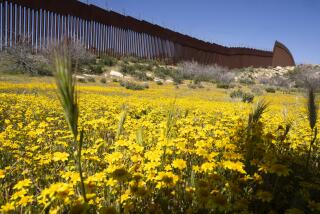World of Nature Altered Under Biosphere 2 Dome : Science: Prototype space colony is evolving. Now the question is whether to tinker--or just watch it grow.
- Share via
ORACLE, Ariz. — One native ant lords over other insects. And the desert got so wet, it’s shrubby with chaparral. Life in Biosphere 2, the domed prototype space colony, has changed in unexpected ways.
Now those who run it are debating how much they should tinker with it or whether they should let nature keep taking its course.
“Do we want to make drastic changes right now, or do we want to . . . see what happens?” said Linda Leigh, a botanist and member of the crew of four women and four men who in September ended a two-year stay.
Until earlier this month, she was also among initial crew members helping scientists take an inventory of how their small world changed in those two years, when the inhabitants grew most of their food and recycled most of their air, water and waste.
They are also deciding what modifications to make before a second crew is sealed in the three-acre complex for several months, probably starting next March.
The $150-million project owned by Space Biospheres Ventures, a private company, is intended to develop technology for a self-sustaining Earth-like environment in space. But a second objective is to use Biosphere 2 to study the environment of what the project refers to as Biosphere 1: Earth.
Organizers of the project--paid for largely by Ft. Worth, Tex., billionaire entrepreneur Ed Bass--say the complex is intended to operate for 100 years.
Biosphere 2 consists of several “biomes” meant to replicate various ecosystems: rain forest, ocean, desert, marsh, savanna and farm.
John Corliss, scientific director of the project in the desert north of Tucson, said changes could be expected as the sealed environment moves toward ecological equilibrium.
While some species died out--notably hummingbirds and many kinds of insects--others, including corals in the miniature ocean, are reproducing.
“That things are reproducing answers questions about long-term sustainability,” Corliss said.
Insect life is now dominated by an ant believed native to Arizona but never studied before, said Leigh, who helped survey plants in the rain forest. She left the project in mid-December to write a book and earn a doctorate.
The ants seem to be altering the rest of the insect population--probably, Leigh said, by eating the adults and eggs of other bug species.
A similar phenomenon has been observed on islands, among them Hawaii, where ants were introduced and eventually controlled the evolution of other insects by eating their eggs and larvae, Leigh said.
“It’s very interesting. And the question is, where do we go from here?” she said.
Then there is the biome designed as a coastal fog desert, like that in Baja California. The desert turned out wetter than planned. Although this caused small succulent plants to die out, faster-growing, thorny shrubs thrived in their place.
“We’re deciding how we want to manage that situation, and there are different possibilities: transforming it, letting it develop the way it is, putting some new plants in,” Corliss said.
Some decisions about tinkering have already been made. Before the air lock closes on the next crew, banks of lights will be installed above the farm to boost production, and tamarisk trees will be planted in the desert to increase its diversity.






